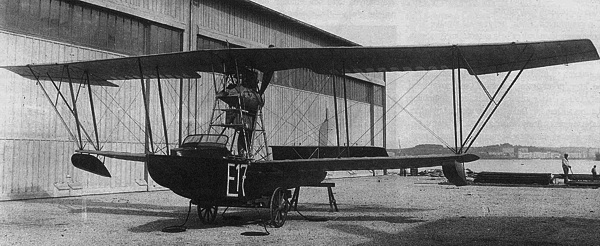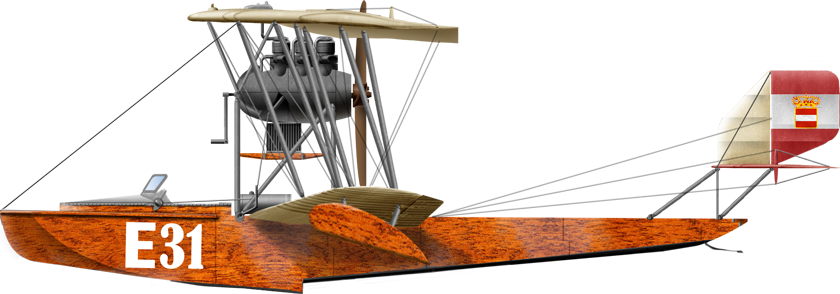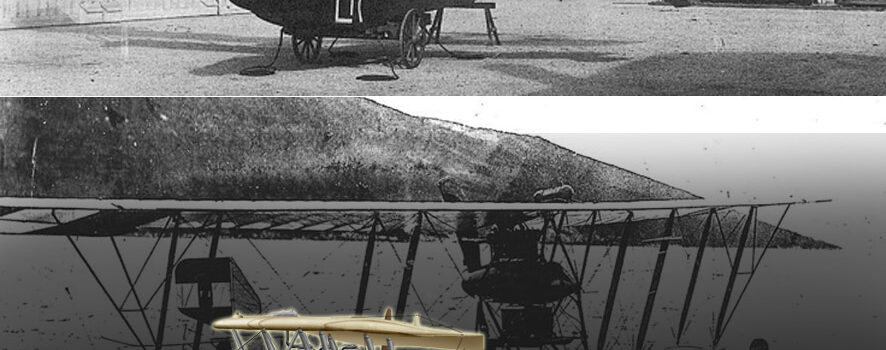The Lohner E was an Austro-Hungarian reconnaissance flying boat of World War I. It was the first engaged in 1914, with “E” standing for Igo Etrich, one of Lohner’s engineers in charge of the project. This conventional design featured slight sweepback, pusher engine in the interplane gap and crew of two seated side by side in the open cockpit, one pilot and one observer. The aircraft was unarmed, lacked speed and agility, and was soon recognized as underpowered. After 40 were made, Lohner moved towards the more powerful L.

General Context
The beginnings of the Austro-Hungarian Naval Air Arm were dictated very much by the conditions encountered in the Adriatic, which were particularly adapted to seaplanes, with pristine and mostly calm waters, and sparkling weather most of the year. The rocky coast was jagged with well usable sites with covered beaches, perfect for small local seaplane bases as well. In this game, however, the first belligerent to understand the game was Austria-Hungary. It developed already from 1912 a dynamic, if not small aircraft industry, and a few seaplanes were already built, but without a military application in mind.
First off, there was already an Austro-Hungarian Naval Air Force before even World War I started. The idea was to use aircraft as reconnaissance aircraft and for artillery spotting for the fleet. With time, other missions developed like defending against enemy aircraft, airships, and later submarines, spotting and destroying minefields at sea, or attacking infrastructure in Italy, providing aerial support to the Isonzo Army.
The Austro-Hungarian naval aviation was notably the first to shoot down of an Allied airship and first to sink a submarine from the air. Corvette Captain Müller von Thomamühl (famous for other reasons like his revolutionary Versuchgleitsboote was the first to test torpedo launches from sea-borne aircraft, in line with the invention and development of torpedoes in Austria-Hungary as well decades prior. Aces were not long in coming like Lt. Gottfried von Banfield, multiplying missions from Trieste with flying boats, braving fighters despite its inherent limitations in manoeuvrability and speed. He even claimed c20 victories, making him the K.u.K. Seefliegerkorps’s top ace, albeit with 9 confirmed postwar, being ranked 15th in Austro-Hungarian aces.
The start of the K.u.K. Seefliegerkorps in 1911 could only count on small scale workshops at the time. There were enthusiastic engineers or just less skills craftsmen so production was very limited at best, with a lot of trials and errors. The first seaplanes in serviced were four French Donnet-Leveque models (Numbered 8, 10, 11 and 12) and a single Curtiss-Farman as N°9. It was Lohner, based in Vienna, that really started the efforts to create a mature seaplane design fit for the needs of the Navy. Meanwhile, pilots lackes naval air facilities and instead treained at the Wiener Neustadt Army Aviation School, also near Vienna.
Naval Air pilots did not enter WWI without any experience still. By April-May 1913, three flying boats took part in the international blockade when the state of Albania was created from the Ottoman Empire in the first Balkan war. It was to force the Serbs to withdraw. In 1913 pilots started to write also procedure for night flight and experimented with early radios.
Development
About Lohner
Lohner-Werke was created originally in Vienna in 1821 and was specialized in luxury horse-drawn carriages. In 1886, Ludwig Lohner (1858-1925), son of the former, succeeded his retired father and by 1892, received the title of Purveyor to the Imperial and Royal Court of the Austro-Hungarian Empire, becoming its largest manufacturer of horse-drawn vehicles. In 1897 he recruited the young Austro-Hungarian inventor Ferdinand Porsche, aged 22, which later would create his own company in Germany, a character which needs no introduction.
From there, Lohner started to manufacture automobiles, notably the world’s first hybrid ones, combining classic petrol engine and electric batteries thanks to Porsche’s genius, but this was not profitable due to the immaturity of batteries at the time. Porsche later left Lohner for Austro-Daimler. Lohner diversified in niche vehicles, trying electric public transport vehicles such as metros, trams, trolleybuses, fire trucks, all in Vienna but also exported to Berlin, Frankfurt or London.
In 1909, the Empire looked at the creation of its own Army aviation corps and Loghner was contracted to create a fleet of 36 Etrich Taube aircraft under licence from 1909. It largely contributed to the Imperial and Royal Austro-Hungarian Troops and the Luftstreitkräfte until 1918. Lohner also produced flying boats (see below) and a domestic model, the Lohner Pfeilflieger. In 1918, the company was the most important aircraft manufacturer in the Empire, with 685 land and sea aircraft under its belt. Under the Armistice of Villa Giusti on November 3, 1918 and Treaty of Saint-Germain, the company was banned from aircraft construction. The activity changed again for scooters and motorbikes in the interwar and beyond, until absorbed by the Canadian Bombardier in 1970…
Lohner Flying Boats

The first seaplane model manufactured in Austria by Lohner was the French Donnet-Leveque flying boat from 1912. Based on this experience, the design team (Igo Etrich, Josef Mickl, Karl Paulal) developed the “E” flying boats (named after the team leader). At first a series of 28 were built by Lohner from its first flight on November 10, 1913. This was essentially an adapted copy of the Donnet-Leveque. The first series of five were completed by January 1914. By late November, one tested the installation of a machine gun (N°17) a change as the crews only until then had carbines and pistols to face Serbian, and later Italian aviation. This first model had a modest output and performances were sufficient for reconnaissance, certainly not for anything else.
Even during the construction of the Lohner “E”, designers were thinking on a new flying boat, of which the first was commissioned in November 1914. It revolved around a much more powerful engine. From 1915, the new Lohner L flying boat was indeed very successful. It was so fast and agile it was armed, and could act as fighter-reconnaissance model. This model was so successful that one was captured and copied by Macchi, creating the first series of Italian military flying boats, Macchi 3 and 5. In 1916, an order was placed to Lohner for large flying boats with a three-person crew and capable of carrying bombs or a torpedo. However, it did not prove successful, due to its engines.
By 1916, Lohner L managed to install absolute air supremacy over the Adriatic,until Italy caught up. The Navy also obtained Friedrichshafen FF33H and Hansa-Brandenburg NW floatplanes from Germany, but supplies were limited, so it was hoped to create a domestic equivalent by late 1916, the K-type flying boats, with 82 built, 29 still in operation by October 1918. At 140 km/h, they were fast and even usable as fighters. They could also carry 200 kg of bombs.
But the company failed to produce a dedicated fighter to defend the main naval base at Pola so six Fokker E IIIs were purchased and arrived by August 1916, armed with local Schwarzlose MG08 machine guns. Still in 1917 was developed at last a rival to the excellent Macchi M5, the Lohner A11 fighter, armed with two machine guns and capable of 180 km/h. But they were not produced. The base instead accepted 24 Hansa Brandenburg CC (designed by Ernst Heinkel). The Phoenix D.I joined this mix of fighters and replaced in 1918 the worn out E-IIIs.
In short
The Lohner E (this code was used by the navy, the factory code was Lohner M) was the first seaplane from the Vienna Lohner-Werke. Its designs were made by engineers Karl Paulal, Igo Etrich and Josef Mickl, and in contrast to the float-based solution, the flying boat form that had proven more successful on the Adriatic was chosen. It was a biplane, its wings were swept slightly backwards and the upper wing was larger than the lower one. Their structure was made of wood and covered with varnished canvas. The two wings were connected by four slightly forward-sloping struts. At the ends of the lower wings, wide, teardrop-shaped floats protected against overturning. The water-cooled, 85 hp Hiero engine was placed above and behind the two-person cockpit and drove a two-bladed pusher propeller. The control surfaces were mounted on a lattice support, raised at the end of the fuselage.
The first, designated E.16, made its test flight on 10 November 1913. Its series was coded E in honour of Igo Etrich and 5 prototypes were built. Later series were equipped with 100 hp Mercedes or Le Rhone rotary engines. At the request of ace pilot Gottfried von Banfield, a single-seat fighter version of the type (called L.16) was also built. It was equipped with a 145 hp Hiero engine, the observer’s seat was removed, and it was armed with two fixed forward-facing machine guns. Banfield achieved eight aerial victories with it, but it was destroyed in an accident in November 1916. It led to no series. As for production, when the model was superseded in 1915 by the Lohner L, far more powerful and faster, most sources agrees that 40 Lohner E were manufactured.
General design
The fuselage was made in agglomerated wood, assembled by heat and using glue, with a slender, 10.5 m fuselage starting with a large nose for two seats in tandem behind a split windscreen, for the pilot and an observer. So the flight commands were only on one side. There was no radio, and the observer just used flags in a preset configuration when a spotter was present to report the information gathered at long distance. In some cases, a capsule with a message (mostly nature of the targets, direction and coordinates) were dropped.
This two-bay biplane was a sequiplane, with a larger upper wing span, of 13 m (upper wing) 8.4 m (lower wing) for a total wing area of 31 m². The wooden fuselage was compartmented to avoid any puncture flooding the hull, and was shaped like a boat, with a tadpole like shape seen from above, large nose for stability and thinner aft section up to the tail. The fuselage measured 9.2 m for a height of 3.1 m. Being almost entirely made of wood, it was light, with an empty weight of just 580 kg and a takeoff weight, with the petrol tank full and crew on board, of 900 kg.
Top speed was unimpressive with its 85 hp four-cylinder in-line, water-cooled Hiero engine, at 90 km/h. It was also anemic and needed 18 minutes to climb to just 1000 meters. Range was 500 km, so just enough to cross a section of the Adriatic and back. It was normally unarmed, albeit most states gives a bomb armament of 150 kg i the shape of hand-held bomblets.
The base reconnaissance model was declined into a fighter, as the need arose, called the L.16. It was shorter in general dimensions, and was powered by a more impressive 145 hp six-cylinder Hiero for a top speed of 140 km/h, a climb rate divided by three and in addition to a modified, narrower cockpit for a single pilot, it was armed with two 8 mm 1907/12 M Schwarzlose machine guns. Albeit production was not ordered, it led to the improved Lohner M (factory code) in reality the model L, which drew all the right lessons from the prototype L.16 and made for an outstanding flying boat.
⚙ Lohner E specifications |
|
| Length: | 10.25 m (33 ft 8 in) |
| Height: | 3.85 m (12 ft 8 in) |
| Upper wingspan: | 16.20 m (53 ft 2 in) |
| Lower wingspan: | Unknown |
| Wing area: | Unknown |
| Empty weight: | Unknown |
| Gross weight: | 1,700 kg (3,747 lb) |
| Powerplant: | Hiero 85 hp , 67 kW (85 hp) |
| Maximum speed: | 105 km/h (65 mph, 56 kn) |
| Cruise speed: | Unknown |
| Range: | Unknown |
| Endurance: | 4 hours |
| Celing: | 4,000 m (13,120 ft) |
| Crew | 1 pilot |
| Armament | None |
The Lohner E in action

The Lohner E was introduced into air units of the k.u.k. Kriegsmarine, operating as an air reconnaissance aircraft, in support of ground operations of the Imperial Royal Army during the Serbian Campaign. After the decision of the Kingdom of Italy to side with the Entente from 24 May 1915, units deployed on the naval stations on the eastern coast of the Adriatic Sea, from Trieste to Dalmatia, operated to counter possible incursions by the Regia Marina. By 1916, the surviving Lohner E were relegated to training and other secondary tasks. The Lohner L replaced it in all units.
Gallery

Illustration of the Lohner E, note 1/72 scale.

Lohner E (‘E17’) at the factory in 1914

Technical drawing (cc)

Type M(E) deployed in September 1914 against the Serbs

Lohner L.16 prototype fighter
Read More/Src
Books
World Aircraft Information Files. London: Bright Star Publishing, pp. File 900 Sheet 20.
Angelucci, Enzo. The Rand McNally Encyclopedia of Military Aircraft, 1914-1980. San Diego. Military Press, 1983.
Taylor, Michael J. H. Jane’s Encyclopedia of Aviation. London: Studio Editions, 1989.
Tucker, Spencer. The Encyclopedia of World War I. Santa Barbara: ABC-Clio, 2005.
Links
doppeladler.com
flyingmachines.ru profiles
en.wikipedia.org Lohner M
theaerodrome.com
bromleyhistoricaltimes.co.uk
it.wikipedia.org
en.wikipedia.org


 Latest Facebook Entry -
Latest Facebook Entry -  X(Tweeter) Naval Encyclopedia's deck archive
X(Tweeter) Naval Encyclopedia's deck archive Instagram (@navalencyc)
Instagram (@navalencyc)





 French Navy
French Navy Royal Navy
Royal Navy Russian Navy
Russian Navy Armada Espanola
Armada Espanola Austrian Navy
Austrian Navy K.u.K. Kriegsmarine
K.u.K. Kriegsmarine Dansk Marine
Dansk Marine Nautiko Hellenon
Nautiko Hellenon Koninklije Marine 1870
Koninklije Marine 1870 Marinha do Brasil
Marinha do Brasil Osmanlı Donanması
Osmanlı Donanması Marina Do Peru
Marina Do Peru Marinha do Portugal
Marinha do Portugal Regia Marina 1870
Regia Marina 1870 Nihhon Kaigun 1870
Nihhon Kaigun 1870 Preußische Marine 1870
Preußische Marine 1870 Russkiy Flot 1870
Russkiy Flot 1870 Svenska marinen
Svenska marinen Søværnet
Søværnet Union Navy
Union Navy Confederate Navy
Confederate Navy Armada de Argentina
Armada de Argentina Imperial Chinese Navy
Imperial Chinese Navy Marinha do Portugal
Marinha do Portugal Mexico
Mexico Kaiserliche Marine
Kaiserliche Marine 1898 US Navy
1898 US Navy Sovietskiy Flot
Sovietskiy Flot Royal Canadian Navy
Royal Canadian Navy Royal Australian Navy
Royal Australian Navy RNZN Fleet
RNZN Fleet Chinese Navy 1937
Chinese Navy 1937 Kriegsmarine
Kriegsmarine Chilean Navy
Chilean Navy Danish Navy
Danish Navy Finnish Navy
Finnish Navy Hellenic Navy
Hellenic Navy Polish Navy
Polish Navy Romanian Navy
Romanian Navy Turkish Navy
Turkish Navy Royal Yugoslav Navy
Royal Yugoslav Navy Royal Thai Navy
Royal Thai Navy Minor Navies
Minor Navies Albania
Albania Austria
Austria Belgium
Belgium Columbia
Columbia Costa Rica
Costa Rica Cuba
Cuba Czechoslovakia
Czechoslovakia Dominican Republic
Dominican Republic Haiti
Haiti Hungary
Hungary Honduras
Honduras Estonia
Estonia Iceland
Iceland Eire
Eire Equador
Equador Iran
Iran Iraq
Iraq Latvia
Latvia Liberia
Liberia Lithuania
Lithuania Mandchukuo
Mandchukuo Morocco
Morocco Nicaragua
Nicaragua Persia
Persia San Salvador
San Salvador Sarawak
Sarawak Uruguay
Uruguay Venezuela
Venezuela Zanzibar
Zanzibar Warsaw Pact Navies
Warsaw Pact Navies Bulgaria
Bulgaria Hungary
Hungary

 Bundesmarine
Bundesmarine Dutch Navy
Dutch Navy Hellenic Navy
Hellenic Navy Marina Militare
Marina Militare Yugoslav Navy
Yugoslav Navy Chinese Navy
Chinese Navy Indian Navy
Indian Navy Indonesian Navy
Indonesian Navy JMSDF
JMSDF North Korean Navy
North Korean Navy Pakistani Navy
Pakistani Navy Philippines Navy
Philippines Navy ROKN
ROKN Rep. of Singapore Navy
Rep. of Singapore Navy Taiwanese Navy
Taiwanese Navy IDF Navy
IDF Navy Saudi Navy
Saudi Navy Royal New Zealand Navy
Royal New Zealand Navy Egyptian Navy
Egyptian Navy South African Navy
South African Navy






























 Ukrainian Navy
Ukrainian Navy dbodesign
dbodesign